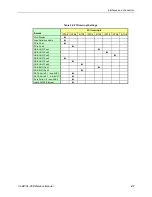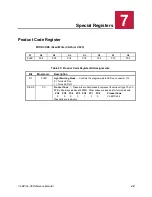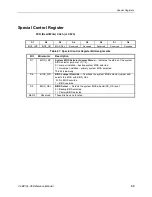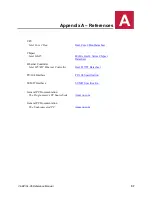
Interfaces and Connectors
VL-EPICs-36 Reference Manual
37
Serial Ports
The VL-EPICs-36 features four on-board 16550-based serial channels located at standard PC I/O
addresses. COM1 and COM2 are RS-232 (115.2K baud) serial ports. IRQ lines are chosen in
CMOS Setup. COM ports can share interrupts with other COM ports, but not with other devices.
COM3 and COM4 can be operated in RS-232 4-wire, RS-422 or RS-485 modes. Additional non-
standard baud rates are also available (programmable in the normal baud registers) of up to 460k
baud. IRQ lines are chosen in CMOS Setup.
Each COM port can be independently enabled, disabled, or assigned a different I/O base address
in CMOS Setup.
COM
P
ORT
C
ONFIGURATION
There are no configuration jumpers for COM1 and COM2 since they only operate in RS-232
mode. Use CMOS Setup to select between RS-232 4-wire, RS-422, and RS485 operating modes
for COM3 and COM4.
Jumper V3[1-2] is used to enable the RS-422/485 termination resistor for COM3. Jumper
V3[3-4] is used to enable the RS-422/485 termination resistor for COM4. The termination
resistor should be enabled for RS-422 and the RS-485 endpoint station. It should be disabled for
RS-232 and the RS-485 intermediate station.
If RS-485 mode is used, the differential twisted pair (TxD+/RxD+ and TxD-/RxD-) is formed by
connecting both transmit and receive pairs together. For example, on VL-CBR-5009 connectors
J6 and J5, the TxD+/RxD+ signal is formed by connecting pins 3 and 5, and the TxD-/RxD-
signal is formed by connecting pins 2 and 4.
RS-485
M
ODE
L
INE
D
RIVER
C
ONTROL
The VL-EPICs-36 features automatic RS-485 direction control for COM3 and COM4. The
purpose of this function is to save the effort of RS-485 direction control in software. The
direction control signal RTS is used to tri-state the transmitter when no other data is available, so
that other nodes can use the shared lines.
RS-485 direction control is set using the Serial Port Mode parameters in CMOS Setup. To enable
manual direction control, set the COM port mode to RS485 ManuFC; to enable auto direction
control, set the parameter to RS485 AutoFC. Manual direction control is configured by asserting
the RTS handshake line. Asserting the RTS handshake line puts the RS-485 port in transmit
mode; de-asserting the line puts it in receive mode.





























